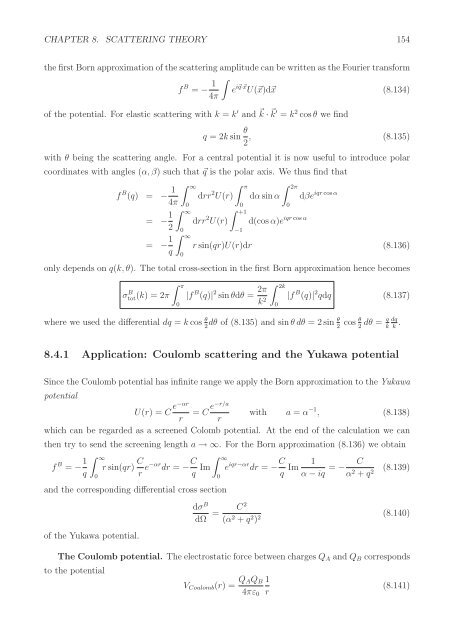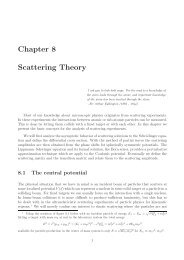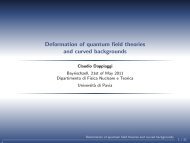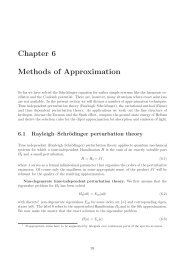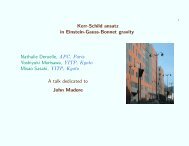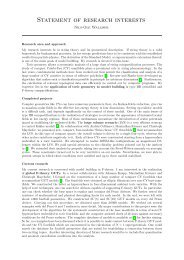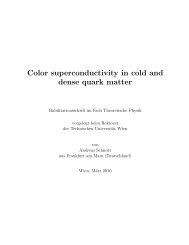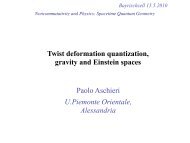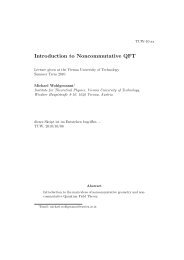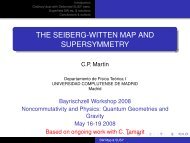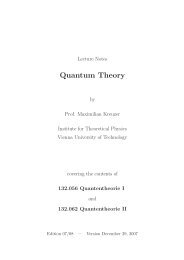Chapter 8 Scattering Theory - Particle Physics Group
Chapter 8 Scattering Theory - Particle Physics Group
Chapter 8 Scattering Theory - Particle Physics Group
You also want an ePaper? Increase the reach of your titles
YUMPU automatically turns print PDFs into web optimized ePapers that Google loves.
CHAPTER 8. SCATTERING THEORY 154<br />
the first Born approximation of the scattering amplitude can be written as the Fourier transform<br />
f B = − 1 ∫<br />
e i⃗q·⃗x U(⃗x)d⃗x (8.134)<br />
4π<br />
of the potential. For elastic scattering with k = k ′ and ⃗ k · ⃗k ′ = k 2 cos θ we find<br />
q = 2k sin θ 2 , (8.135)<br />
with θ being the scattering angle. For a central potential it is now useful to introduce polar<br />
coordinates with angles (α,β) such that ⃗q is the polar axis. We thus find that<br />
f B (q) = − 1<br />
4π<br />
= − 1 2<br />
= − 1 q<br />
∫ ∞<br />
0<br />
∫ ∞<br />
0<br />
∫ ∞<br />
0<br />
drr 2 U(r)<br />
drr 2 U(r)<br />
∫ π<br />
0<br />
∫ +1<br />
−1<br />
dα sin α<br />
∫ 2π<br />
0<br />
iqr cos α<br />
d(cos α)e<br />
iqr cos α<br />
dβe<br />
r sin(qr)U(r)dr (8.136)<br />
only depends on q(k,θ). The total cross-section in the first Born approximation hence becomes<br />
∫ π<br />
σtot(k) B = 2π |f B (q)| 2 sin θdθ = 2π ∫ 2k<br />
|f B (q)| 2 qdq (8.137)<br />
0<br />
k 2 0<br />
where we used the differential dq = k cos θ 2 dθ of (8.135) and sinθ dθ = 2 sin θ 2 cos θ 2 dθ = q k<br />
dq<br />
k .<br />
8.4.1 Application: Coulomb scattering and the Yukawa potential<br />
Since the Coulomb potential has infinite range we apply the Born approximation to the Yukawa<br />
potential<br />
U(r) = C e−αr<br />
= C e−r/a<br />
with a = α −1 , (8.138)<br />
r r<br />
which can be regarded as a screened Colomb potential. At the end of the calculation we can<br />
then try to send the screening length a → ∞. For the Born approximation (8.136) we obtain<br />
f B = − 1 q<br />
∫ ∞<br />
0<br />
r sin(qr) C r e−αr dr = − C ∫ ∞<br />
q Im e iqr−αr dr = − C q Im 1<br />
α − iq = − C (8.139)<br />
α 2 + q 2<br />
and the corresponding differential cross section<br />
of the Yukawa potential.<br />
0<br />
dσ B<br />
dΩ = C 2<br />
(α 2 + q 2 ) 2 (8.140)<br />
The Coulomb potential. The electrostatic force between charges Q A and Q B corresponds<br />
to the potential<br />
V Coulomb (r) = Q AQ B 1<br />
4πε 0 r<br />
(8.141)


